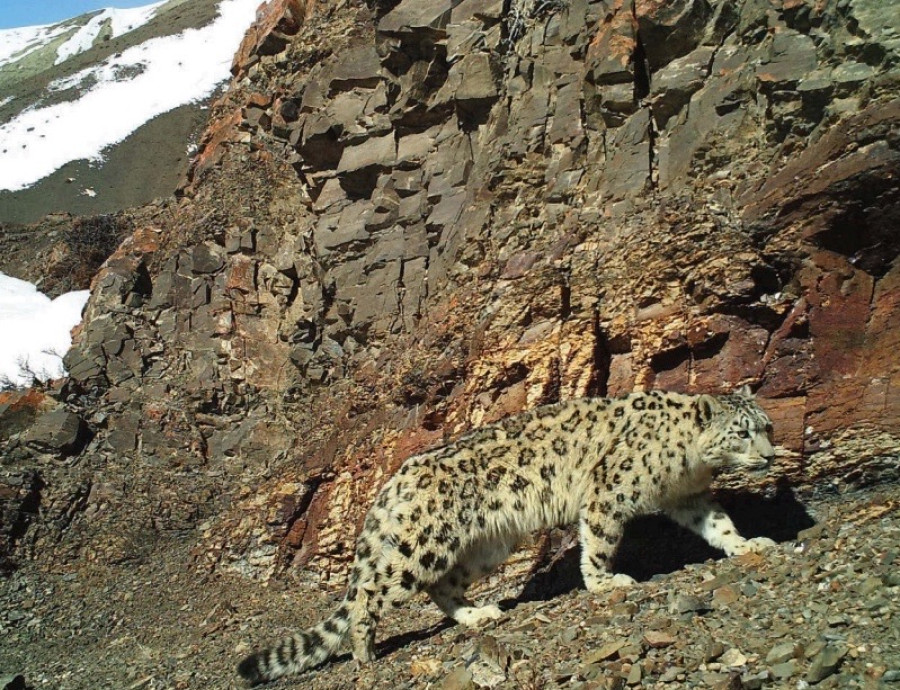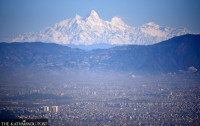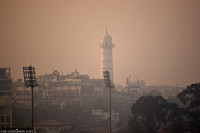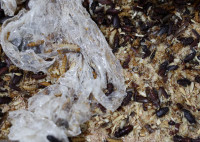Climate & Environment
Snow leopard population fragmentation in Everest region raises concerns
Researchers discover two clusters of the iconic species with limited genetic diversity in the region.
Abhaya Raj Joshi & Chandan Kumar Mandal
Until 2004, the scientific community and even the local residents of the Everest region were not sure if the elusive snow leopards roamed the area. But with a snow leopard being photographed in the region, there were hopes that the vulnerable species was expanding its habitat and conservation efforts were paying off.
Nearly 17 years after the discovery of the animal, findings of a new research suggest that the population of snow leopards has been fragmented into two, with limited communication and breeding between the members of the two groups.
“We found that there were two groups of snow leopards in the Everest region, and it is difficult for them to breed with one another,” Bikram Shrestha, who carried out the research as part of his PhD degree at the Global Change Research Institute, Czech Academy of Sciences and Charles University, told the Post over the phone from the Czech Republic.
As part of their research, Shrestha and his team used the data collected in Nepal to create habitat suitability maps and describe the genetic structure of the snow leopard within and between the areas on the map. With the help of the model, they also looked at how landscape features affect the genetic structure of snow leopard populations and corridors connecting their potential habitats.
The global snow leopard population of 7,367- 7,884 is spread over 12 countries, according to IUCN. In Nepal, the population, divided into western, central and eastern blocks, is estimated to be around 300-400 individuals.
The establishment of Everest National Park in 1976 led to increased conservation efforts in the area. This meant a healthy growth in the population of ungulates. Researchers believe this might be the reason, snow leopards came to the area from the west and the north in the early 2000s.
“We found that that population of snow leopards in the Everest region was spatially separated into two clusters: one in the northern and the other in the south-western part,” said Shrestha, whose team collected snow leopard scats and hair from the central and eastern blocks of snow leopard habitat for the study.
In Nepal, snow leopards live within and outside mountain protected areas where their habitat is broadly arranged into three large snow leopard conservation landscapes: eastern, central, and western.
The eastern landscape extends from Kangchenjunga Conservation Area to Langtang National Park (LNP). The central landscape spreads from LNP (west) to Tscharka Pass near the western fringe of Annapurna Conservation Area.
The western landscape–the largest in terms of area— is home to the largest population of snow leopards in Nepal. It extends from Tscharka pass to Api-Nampa Conservation Area in the far-western part of the country and includes Dhorpatan Hunting Reserve (DHR), Shey Phoksundo National Park (SPNP), Rara National Park and Khaptad National Park, according to the Snow Leopard Conservation Action Plan (2017-2021).
The potential snow leopard habitat is estimated to be an area of 13,000 sq km in Nepal.
“Our connectivity and genetic analyses indicate that the populations in the north and the south-western regions of Everest are genetically isolated from each other,” said Shrestha.
The plausible reason for genetic isolation, the researchers found, was that the snow leopards came to the Everest region from different source populations.
“The gene flow between these sites might have been limited due to the barrier posed by two large rivers (Dudh Kosi and Imja) separating them. Also, the only possible connection between these sub-populations is narrow and is used by hundreds of tourists on the route to Namche Bazaar,” said Shrestha.
Generally, predators avoid large or frequented roads and trails, especially in areas where hunting or harassment is common.
The research concludes that it is necessary to protect natural corridors so that snow leopards can move between areas of suitable habitats.
“This is essential for the gene flow between the diminishing or even disappearing populations and for the survival of a viable population of this rare species,” said Shrestha.
Maintenance of these corridors may also help preserve the habitat connectivity for other species such as wolves, lynx, golden jackal and red foxes detected in camera traps and carnivore DNA sequence.
“For any species to survive for the long-term, there has to be a viable population. If there is no connectivity of habitats, it can lead to inbreeding depression among species,” said Gopal Khanal, a snow leopard researcher. “But if there is a less diverse gene pool, then the species cannot adapt to sudden change.”
“The growing development aspirations and several north-south corridor connectivity will further fragment and break natural connectivity of snow leopards,” said Khanal, who is also an assistant conservation officer at the Shey Phoksundo National Park. “Besides, fragmentation also increases human disturbance and can also break their natural dispersal.”
Under the Bishkek Declaration on the Conservation of the Snow Leopard, 12-snow leopard countries, in 2013, acknowledged the elusive species an irreplaceable symbol of these nations’ natural and cultural heritage and an indicator of the health and sustainability of mountain ecosystems. They also expressed their commitment to work together to protect their habitat and concern about the increasing threats arising from growing human footprint and climate change to the survival of snow leopards.
In Nepal, retaliatory killing of snow leopards following livestock depredation and crop damage by prey species remains one of the major challenges behind its conservation. Climate change, which is expected to affect the fragile mountain environment more than any other areas on earth, also poses a greater risk to the future of snow leopards.
“We don’t know the collective gene pool status of these snow leopards to know how genetically diverse they are. The existing snow leopard action plan has also talked about conducting research on connectivity. We do not have much idea on whether cross-breeding is happening or not,” said Khanal. “As there have been studies on tiger genome, we can have similar genome study on snow leopards which will reveal about their gene diversity.”
Meanwhile, Shrestha says that many aspects of snow leopards still remain a mystery even for those who have dedicated their career in studying them. “We still do not know whether snow leopards really use corridors between sites. This lack of understanding prevents us from effectively conserving snow leopards. Thus, intensive research in this field is crucial.
“But we do know that to ensure gene flow between individual populations of snow leopard metapopulations, a good connectivity between snow leopard sites is crucial.”




 9.12°C Kathmandu
9.12°C Kathmandu









%20(1).jpg&w=300&height=200)

